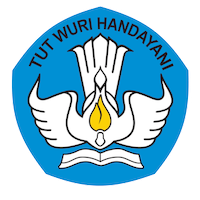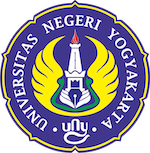Quick healing on wound can be accelerated with compounds having anti-inflammatory properties to reduce the signs and symptoms of inflammation. Among these anti-inflammatory compounds are contained in the ketapang(terminalia catappa) leaves. . This attracted the attention of a group of UNY students, namely Asmi Aris (chemical education study program), Miya Kurniawati (sports coaching education program) and Jefri Eko Cahyono (communication science study program) to study ketapang leaves as an anti-inflammatory ointment.
Asmi Aris said that ketapang (Terminalia Catappa) contains medicinal compounds such as flavonoids, alkaloids, tannins, titerpenoids or steroids, and saponins. "Ketapang is a type of vascular plant, which has tannin content," he said. Tannin can be used as an antibacterial in wounds because in tannins there are phenol group compounds. The phenol group in tannin has alcoholic properties which act as antiseptics. According to Miya Kurniawati when a part of the body has an open wound, the inflammatory mechanism will help eliminate damaged cells and speed up the healing process. "Inflammation is the first immune response to damage foreign substances or objects that are considered harmful, be it damaged cells, bacteria, or viruses," Miya said. Eliminating foreign substances or objects is important to begin the healing process. Through various other mechanisms, inflammatory cells in the blood vessels trigger swelling in areas of the body that are damaged and cause swelling, redness, and pain. Inflammation will indeed cause discomfort, but it is important in the healing process.
Jefri Eko Cahyono explained that the anti-inflammatory ointment product of Ketapang (Terminalia catappa) ointment as an isolusilukisiisi will be processed into an agronomically prepared plastic form according to the needs, from which the product is in the form of a thick and flexible container. The formulation stage, ketapang leaf extract is made by maceration. A total of 50 g of finely ground powder soaked in 70% ethanol as much as 500 mL with a ratio of 1:10 adjusted in the Indonesian Pharmacopeia for 5 days. After 5 days debris I and filtrate I separated using filter paper. From these results then debris I soaked again using 70% ethanol as much as 400 mL for 2 days with occasional stirring. Then debris II and filtrate II are separated using filter paper. From these results then debris II was soaked again using 70% ethanol as much as 300 mL for 1 day with occasional stirring. After 1 day debris III and filtrate III were separated using filter paper. Filtrate I, Filtrate II, and Filtrate III are combined and refined to ensure no debris is included and to obtain a total mass of daunketapang. Then it is evaporated using a vacuum evaporator with a temperature of 60oC so that the extract is almost thick and followed by using a water bath with a temperature of 60oC to obtain a thick extract. Based on the results of research conducted ketapang leaves can inhibit the growth of Staphylococcus aureus. The anti-inflammatory ointment of ketapang leaves is expected to improve the quality of life of patients to heal incision wounds and be a solution to the problem for patients to heal incision wounds that are expected to be globally competitive. (Dedy_Luka is damage to the continuity of the skin, mucous membranes and bones or other organs causing a traumatic effect. Disruption of continuity of a tissue in the skin causes the separation of tissue that was normal to abnormal. The incision is a type of wound caused by the sliced instrument instrument The process of wound healing that occurs to deal with scars can be accelerated with compounds that have anti-inflammatory properties to reduce the signs and symptoms of inflammation.These anti-inflammatory compounds are contained in daunketapang.This attracts the attention of a group of UNY students namely Asmi Aris educational study program chemist, Miya Kurniawati, a sports coaching education program and Jefri Eko Cahyono, a communication science study program to study ketapang leaves as an anti-inflammatory ointment.
Asmi Aris said that ketapang (Terminalia Catappa) contains medicinal compounds such as flavonoids, alkaloids, tannins, titerpenoids or steroids, and saponins. "Ketapang is a type of vascular plant, which has tannin content," he said. Tannin can be used as an antibacterial in wounds because in tannins there are phenol group compounds. The phenol group in tannin has alcoholic properties which act as antiseptics. According to Miya Kurniawati when a part of the body has an open wound, the inflammatory mechanism will help eliminate damaged cells and speed up the healing process. "Inflammation is the first immune response to damage foreign substances or objects that are considered harmful, be it damaged cells, bacteria, or viruses," Miya said. Eliminating foreign substances or objects is important to begin the healing process. Through various other mechanisms, inflammatory cells in the blood vessels trigger swelling in areas of the body that are damaged and cause swelling, redness, and pain. Inflammation will indeed cause discomfort, but it is important in the healing process.
Jefri Eko Cahyono explained that the anti-inflammatory ointment product of Ketapang (Terminalia catappa) ointment as an isolusilukisiisi will be processed into an agronomically prepared plastic form according to the needs, from which the product is in the form of a thick and flexible container. The formulation stage, ketapang leaf extract is made by maceration. A total of 50 g of finely ground powder soaked in 70% ethanol as much as 500 mL with a ratio of 1:10 adjusted in the Indonesian Pharmacopeia for 5 days. After 5 days debris I and filtrate I separated using filter paper. From these results then debris I soaked again using 70% ethanol as much as 400 mL for 2 days with occasional stirring. Then debris II and filtrate II are separated using filter paper. From these results then debris II was soaked again using 70% ethanol as much as 300 mL for 1 day with occasional stirring. After 1 day debris III and filtrate III were separated using filter paper. Filtrate I, Filtrate II, and Filtrate III are combined and refined to ensure no debris is included and to obtain a total mass of daunketapang. Then it is evaporated using a vacuum evaporator with a temperature of 60oC so that the extract is almost thick and followed by using a water bath with a temperature of 60oC to obtain a thick extract. Based on the results of research conducted ketapang leaves can inhibit the growth of Staphylococcus aureus. The anti-inflammatory ointment of ketapang leaves is expected to improve the quality of life of patients to heal incision wounds and be a solution to the problem for patients to heal incision wounds that are expected to be globally competitive. (Dedy; Tj.Lak)





